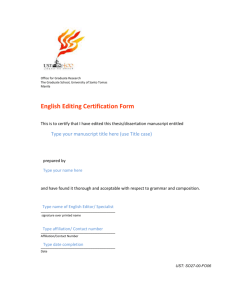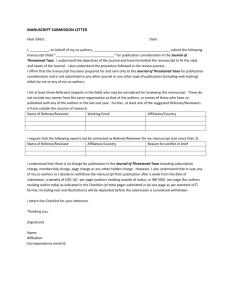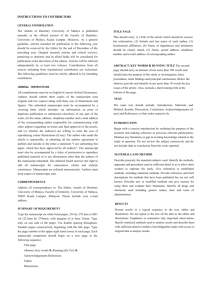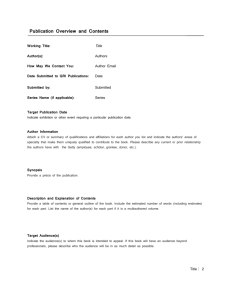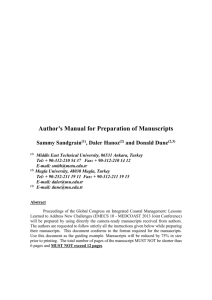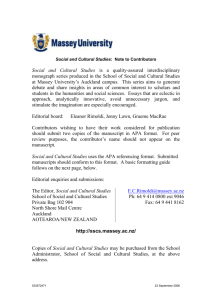Manuscript Template - International Association of Cultural and
advertisement
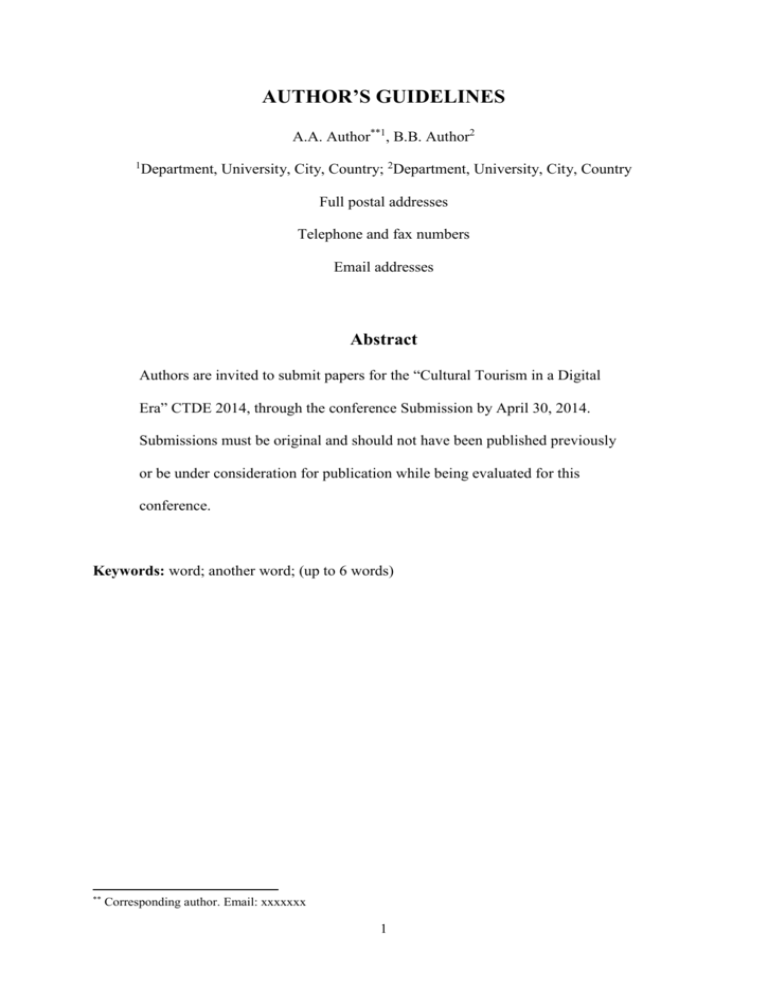
AUTHOR’S GUIDELINES A.A. Author**1, B.B. Author2 1 Department, University, City, Country; 2Department, University, City, Country Full postal addresses Telephone and fax numbers Email addresses Abstract Authors are invited to submit papers for the “Cultural Tourism in a Digital Era” CTDE 2014, through the conference Submission by April 30, 2014. Submissions must be original and should not have been published previously or be under consideration for publication while being evaluated for this conference. Keywords: word; another word; (up to 6 words) ** Corresponding author. Email: xxxxxxx 1 AUTHOR’S GUIDELINES Abstract Authors are invited to submit papers for the “Cultural Tourism in a Digital Era” CTDE 2014, through the conference Submission by April 30, 2014. Submissions must be original and should not have been published previously or be under consideration for publication while being evaluated for this conference. Keywords: word; another word; (up to 6 words) 2 Introduction All manuscripts must be prepared in English and be free of grammatical, spelling, and/or punctuation errors and must be prepared using APA format,6th edition, http://www.apastyle.org/ and http://blog.apastyle.org/. Authors are urged to write as concisely as possible, but not at the expense of clarity. Please make sure the paper is thoroughly edited and proofread before submission. Research Papers should be not longer than 6500 words and not shorter than 4000 (excluding references). Manuscript Presentation All authors of a manuscript should include their full names, affiliations, postal addresses, telephone numbers and email addresses on the cover page of the manuscript. One author should be identified as the corresponding author. Please give the affiliation where the research was conducted. If any of the named co-authors moves affiliation during the peer review process, the new affiliation can be given as a footnote. Please note that no changes to affiliation can be made after the manuscript is accepted. Please note that the email address of the corresponding author will normally be displayed in the article PDF (depending on the journal style) and the online article. All persons who have a reasonable claim to authorship must be named in the manuscript as co-authors; the corresponding author must be authorized by all co-authors to act as an agent on their behalf in all matters pertaining to publication of the manuscript, and the order of names should be agreed by all authors. Please supply a short biographical note for each author. For submission, manuscripts of research papers, research notes and case studies should be arranged in the following order of presentation: Cover page 3 Title, subtitle (if required), author’s name and surname, affiliation, full postal address, telephone and fax numbers, and e-mail address. Respective names, affiliations and addresses of co-author(s) should be clearly indicated. Also, include an abstract of not more than 250 words and up to 6 keywords that identify article content. Also include a short biography of the author (about 50 words); in the case of co-author(s), the same details should also be included. All correspondence will be sent to the first named author, unless otherwise indicated. Follow the following instructions: Title: Bold, first word and proper nouns cap only (title of no more than 12 words) Authors: An Author1 and Another Author2 (initials closed up if J.B. Author) Affiliation: 1Department, University, City, Country; 2Department, University, City, Country, Abstract: Indented both sides Keywords: word; another word; (up to 6 words) Correspondence details: Given as footnote on page 1**Corresponding author. Email: xxxxxxx ranged left, no indent. Postal address not included in footnote. If there is only one author, use *Email: xxxxxxx Title page The second page consists of the manuscript title, an abstract of not more than 250 words and up to 6 keywords that identify article content. To facilitate the double-blind review process no material that identifies the author(s) should be placed in this page. Subsequent pages The paper should begin on the third page and should not subsequently reveal the title or authors. All manuscripts should include at least the following sections: introduction, literature review, methodology, results, discussions, implementations, limitations, and conclusions, 4 followed by references, tables, and figures. The author(s) should ensure that their names cannot be identified anywhere in the text. General Guidelines The general style of manuscripts should be prepared in accordance with the APA Publication Manual, 6th ed. http://www.apastyle.org. All parts of the manuscript should be: Times New Roman font size 12 including tables, figures and references, Manuscripts should be double-line spaced, and have 2,54 cm (one-inch) margin on all four sides. Pages should be numbered consecutively. Indent the first line of every paragraph one-half inch Align the text to the left-hand margin Section headings should be marked as follows: primary headings should be typed in bold capitals; secondary headings should be typed with italic bold letters. The use of footnotes within the text is NOT allowed – use endnotes instead. Endnotes should be kept to a minimum, be used to provide additional comments and discussion, and should be numbered consecutively in the text and typed on a separate page at the end of the article. Where acronyms are used, their full expression should be given initially. Quotations must be taken accurately from the original source. Alterations to the quotations must be noted. Quotation marks (“ ”) are to be used to denote direct quotes. Inverted commas (‘ ‘) should denote a quote within a quotation. If the quotation is less than 3 lines, then it should be included in the main text enclosed in quotation marks. If the quotation is more than 3 lines, then it should be separated from the main text and indented. This is the text, and Smith (2012) says “quoted text” (p. 1), which supports my argument. This is the text, and this is supported by “quoted text” (Smith, 2012, p. 1). This is a displayed quotation. (Smith, 2012, p. 1) 5 References, citations, and general style of manuscripts should be prepared in accordance with the APA Publication Manual, 6th ed. http://www.apastyle.org. All references cited in the article must be listed in the References and the names must be spelled correctly and typed in alphabetical order of authors. Cite in the text by author and date (Ford, 1983), or for many authors (Anderson, Christoff, Panitz, De Rosa, & Gabrieli, 2003; Ohman & Mineka, 2001) and for more than five authors (Carretie et al., 2004). Examples: Journal: Author, M., & Autho, N. N. (1978). Therapy groups for women sexually molested as children. Archives of Sexual Behaviour, 7(6), 417-427. doi:10.1037/00963445.134.2.258 Book: Author, M. (1980). Such a pretty face. New York: W. W. Norton. Contribution to a Book: Author, J. T., & Author, D. A. (1980). Contemporary issues in adult development of learning. In L. W. Poon (Ed.), Ageing in the 1980s (pp. 239-252). Washington, DC: American Psychological Association. Internet sources : Author, D. (2003). The power of branding in tourism. Tourism Marketing 22, 237-246. Retrieved from http://www.tourismabstracts.org/marketing/papersauthors/id3456. Accessed the 12 th of January 2005, at 14:55. (Note: always state clearly the full URL of your source). Acknowledgement Acknowledgement is optional and should appear after the references and before the appendices. Please supply all details required by any funding and grant-awarding bodies as an Acknowledgement as follows: For single agency grants: ”This work was supported by the [Funding Agency] under Grant [number xxxx].” 6 For multiple agency grants: ”This work was supported by the [Funding Agency 1] under Grant [number xxxx]; [Funding Agency 2] under Grant [number xxxx]; and [Funding Agency 3] under Grant [number xxxx].” Any appendices should appear at the end of the article after the list of references and acknowledgement (if applicable). Illustrations Illustrations submitted (line drawings, halftones, photos, photomicrographs, etc.) should be clean originals or digital files. Digital files are recommended for highest quality reproduction and should follow these guidelines: 300 dpi or higher Sized to fit on journal page EPS, TIFF, or PSD format only Submitted as separate files, not embedded in text files Color Reproduction Color art will be reproduced in the online production at no additional cost to the author. Color illustrations will also be considered for the print publication Tables and Figures Tables and figures (illustrations) should not be embedded in the text. A short descriptive title should appear above each table with a clear legend and any footnotes suitably identified below. Tables, figures and illustrations are to be numbered consecutively (in Arabic numbers). All units must be included. Figures should be completely labeled, taking into account necessary size reduction. Please make sure that all tables, figures, and charts are complete, accurate, correctly titled according to APA format, and are correctly referenced in the text. If any table, figure or 7 chart is taken directly from another publication, you need to include a release (permission to publish) from the original publisher. Proofs Page proofs are sent to the designated author. They must be carefully checked and returned within 48 hours of receipt. Editorial Processing All manuscripts undergo an initial review process involving IJCT editors and may include members of the editorial board. This process can take as long as two to four weeks, after which manuscripts are either rejected or sent into peer review pursuant possible publication. Peer review may take an additional eight to ten weeks. The decision to publish is ultimately predicated upon the outcome of peer review, the judgement of IJCT editors, and, if necessary, a satisfactory ending and/or revision process that meets IJCT standards. Author(s) are responsible for preparing manuscripts which are clearly written in acceptable, scholarly English, and which contain no errors of spelling, grammar, or punctuation. Neither the Editorial Board nor the Publisher is responsible for correcting errors of spelling or grammar. 8 Table 1. Example Table Caption: Content Analysis Results of Comparison of Hall and Van De Castle Female Norm Dreams With Most Recent Dreams Hall and Van De Content Castle female norms Most recent Male/female characters 48 56 Familiar characters 58 57 Friends 37 34 Family 19 20 Dead and imaginary 1 2 Animals 4 7 Aggression/friendliness 51 53 Physical aggression 34 48 Negative emotions 80 80 Aggression, at least 1 44 41 Friendliness, at least 1 42 40 Sexuality, at least 1 4 12 Misfortune, at least 1 33 34 Good fortune, at least 1 10 12 9 Figure 1. Example figure caption: IACuDiT 10 Appendix A. Should you have further questions regarding paper submission or other affairs, please contact us by clicking here 11

